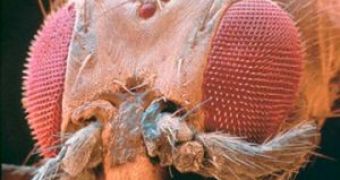A compound eye is a visual organ found in insects and some crustaceans.
Such an eye has 12 to 1,000 ommatidia. These are tiny sensors that distinguish between brightness and darkness, and sometimes can detect color, and structurally correspond to the ocular globe of the vertebrates. The image perceived by the arthropod is a combination of inputs from the numerous ommatidia, which are oriented to point in slightly different directions. Unlike other types of eyes, a compound eye does not have a central lens or retina, resulting in poor image resolution; however, it can detect fast movement (flies) and, in some cases, the polarization of light (bees). Each ommatidium consists of a lens and several visual receptor cells parallel to each other or slightly twisted.
Recently, a team of biologists at the University of California, San Diego have discovered that the presence of a protein in the compound eyes of the fruit fly (photo)(which glow at center due to a fluorescent protein) enables the formation of distinct light gathering units in each of its 800 ommatidia.
This evolutionary "open system" enabled insects to make significant improvements in visual acuity and angular sensitivity. Most insects, like beetles, bees and mosquitoes (which are in fact primitive flies) species have the light-gathering units fused together into a "closed system."
One of three proteins needed to form these light gathering units is present in the visual system of fruit flies, house flies and other insects with open eye systems, but conspicuously absent in species with closed systems. The loss of this protein, called "spacemaker," can convert the eyes of fruitflies-which normally have open eye systems-into a closed one.
In contrast, the introduction of spacemaker into eyes with a closed system transformed them into an open one. "These results help illustrate the beauty and power of evolution and show how 'little steps'-like the presence of a single structural protein-can so spectacularly account for major changes in form and function," said Charles Zuker, a professor of biology and neurosciences at UCSD.

 14 DAY TRIAL //
14 DAY TRIAL //